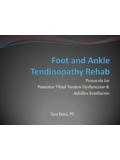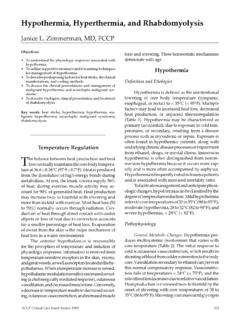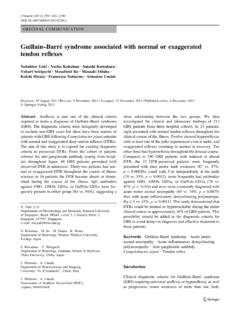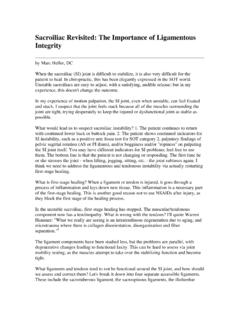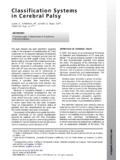Transcription of Posterior Tibialis Tendon Dysfunction (PTTD)
1 Patient information leafletPosterior Tibialis Tendon Dysfunction ( pttd )Physiotherapy Department2 This leaflet has been designed to provide information about the condition Posterior Tibialis Tendon Dysfunction and guidance in its may have been invited to Tibialis Posterior Tendon Dysfunction Group, where physiotherapist may have explained the condition to you and advised you on an appropriate treatment Tibialis Tendon Dysfunction ( pttd ) is one of several terms used to describe a painful, progressive flat foot deformity in adults.
2 Other terms include Posterior Tibial Tendon Insufficiency and Adult Acquired Flat foot is Posterior Tibialis Tendon Dysfunction ? Tendons are the structures responsible for connecting muscle to bone. The Posterior Tibialis Tendon is one of the most important tendons of the leg. It starts at a muscle in the calf, travels down the inside of the lower leg and attaches to the bones on the inside of the Tendon serves as one of the major supporting structures in maintaining the foot s arch and helps the foot to function whilst injury or degeneration of the Tendon can cause the arch to sag/ collapse resulting in a flat foot (pes planus) deformity.
3 pttd may mean you are no longer able to stand on does pttd occur? Dysfunction occurs when the Tendon becomes too long to function due to being inflamed, weakened, or ruptured. This may lead to pain and/or weakness and the inner arch of the foot slowly becomes flatter. There are two specific ways in which pttd can be caused: 1. A tear in the Tendon that develops over a period of time. This is usually related to a slow developing (degenerative) breaking of the fibres of the Tendon . The degeneration causes the Tendon to lengthen and to become weak.
4 The loss of Tendon strength is important as it then loses its ability to support the arch of the foot. 32. Following an injury a blow to the inside part of the ankle or a twisting injury that results in a complete or partial tear of the Tendon . An injury to the ligaments in the foot can cause the joints to fall out of alignment. In addition to ligament injuries, fractures and dislocations of the bones in the midfoot can also lead to a flatfoot factors may contribute to the development of pttd ?
5 This condition occurs slightly more often in women and it usually starts to occur after 40 years of age. There are however several other risk factors, including:Mechanical factorsHigh impact sports, such as basketball, tennis, or soccer, may cause tears of the Tendon from repetitive use. Tight calf muscles Pre-existing flexible flat feet Obesity Extrinsic Factors DiabetesPost menopausal High blood pressure (hypertension) Inflammatory (rheumatological) diseases such as Reiter s disease, Rheumatoid Arthritis, spondylosing arthropathy and psoriasis Previous surgery or trauma Local steroid injections (although sometimes steroid injections are used for very specific reasons in this disorder).
6 4 What are the symptoms of pttd ?Depending on the cause of the flatfoot, a patient may experience one or more of the different symptoms below Pain on the inside of ankle or foot, redness, warmth and swelling along the course of the Tendon . Pain worse with activity. High intensity or impact activities, such as running, can be very difficult. Some patients can have difficulty walking or even standing for long periods of time. A change in the shape of the foot. The heel may be tilted outward and the arch will have flattened/collapsed.
7 Too many toes sign. When looking at the heel from the back, usually only the fifth toe and half of the fourth toe are seen. In a flatfoot deformity, more of the lesser toes can be seen. As pttd the foot collapses, the heel bone may shift to a new position outwards. This can put pressure on the outside ankle bones causing pain. Ankle joint osteoarthritis can develop in more severe cases. What are the treatment options? Conservative treatment (non surgical treatment) is initially indicated for nearly all patients before surgical management is considered.
8 However, this is dependent on how far the condition has advanced and whether the condition is traumatic or degenerative. Initial conservative treatment often consists of rest (in a removable Air Cast Boot or a splint), ice, compression and elevation (known as RICE). Your doctor may prescribe a course of anti-inflammatory drugs to reduce swelling and pain. In some cases, immobilisation of the foot in a removable boot for 6-8 weeks may be necessary to prevent over use and to minimise load on the Tendon .
9 5A referral for insoles is highly recommended to correct rearfoot (heel) position in order to off-load the Tendon and decrease strain, which will help it to recover. Physiotherapist will advise you on the best form of treatment. You will be provided with exercises to stretch your calf muscles and strengthen the Tendon to improve its function. Physiotherapist can also provide advice on shoe wear, change of activities, and pain management.
10 Here there are examples of some exercises you may be taught to start manage your condition. Gastrocnemius stretch on a slant board a) Wearing trainers or your shoes with insoles stand on a slope/incline/slant board. b) Lean your whole body slightly forward, keeping straight. c) Hold for 3 minutes, repeat 3 times a day. Inversion exercise a) Hold a theraband in your hands. b) Move your hands to the outside of the knee. c) Turn your foot inward, against the theraband resistance.





